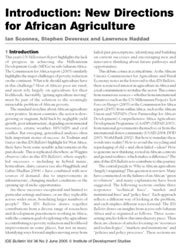{jathumbnail off}{jcomments off} This year’s UNMillennium Report highlights the lack of progress in achieving the Millennium Development Goals (MDGs) in sub-Saharan Africa. The Commission for Africa report (2005) similarly highlights themajor challenges of poverty reduction on the continent.What role should agriculture have in this challenge? Most of Africa’s poor are rural, and most rely largely on agriculture for their livelihoods. Inevitably, “getting agriculture moving” must be part of the solution to the seemingly intractable problem of African poverty.
This year’s UNMillennium Report highlights the lack of progress in achieving the Millennium Development Goals (MDGs) in sub-Saharan Africa. The Commission for Africa report (2005) similarly highlights themajor challenges of poverty reduction on the continent.What role should agriculture have in this challenge? Most of Africa’s poor are rural, and most rely largely on agriculture for their livelihoods. Inevitably, “getting agriculture moving” must be part of the solution to the seemingly intractable problem of African poverty.
The standard storyline about African agriculture is not positive. In most countries, the sector is slow growing or stagnant, held back by negligible yield growth, poor infrastructure, degrading environmental resources, erratic weather, HIV/AIDS and civil conflict. But sweeping, generalised analyses often hide important stories of success. As Toulmin and Guèye (in this IDS Bulletin) highlight for West Africa, there have been some notable achievements in the past decade. This is replicated elsewhere, as Wiggins observes (also in this IDS Bulletin), where supplyled successes – including in hybrid maize, horticulture, dairy, cassava (see also Haggblade and Gabre-Madhin 2004) – have combined with new sources of demand, due to improvements in infrastructure, changing market conditions or the opening up of niche opportunities. Are these successes exceptional and limited to particular settings and times, or are they replicable across wider areas, benefiting larger numbers of people?
This IDS Bulletin draws together contributions from a diverse range of researchers and development practitioners working in Africa, with the common goal of exploring why agriculture is contributing to poverty reduction and livelihood improvement in some places, but not in many. Identifying ways forward implies moving away from failed past prescriptions, identifying and building on current successes and encouraging new and innovative thinking about future pathways and opportunities. This debate comes at a critical time. As the African Union’s Commissioner for Agriculture and Rural Economy notes in the foreword to this IDS Bulletin, there is renewed interest in agriculture in Africa and a real commitment to revitalise the sector.
This comes fromnumerous sources – whether frominternational initiatives such as the UNMillenniumProject’s Task Force onHunger (2005) or theCommission for Africa report (2005); from within Africa, such as the African Union and NEPAD’s (New Partnership for Africa’s Development) Comprehensive Africa Agriculture Development Programme(CAADP) (NEPAD 2003), from national governments themselves or from the international donor community (USAID 2004; DFID 2003; World Bank 2002). But how to translate these words into reality? How to avoid the recycling and repackaging of old – and often failed – ideas? How to generate new thinking, rooted in African contexts and ground realities, whichmakes a difference? The aim of this IDS Bulletin is to contribute to this journey.
The central puzzle is: Why is African agriculture (largely) stagnating? This question is not new. Many have commented on the failures of an African “green revolution”, and many explanations have been suggested. The following sections outline three responses: “technical fixes”, “market and institutional fixes” and “policy fixes”. Each approach reflects a different way of looking at the problem, and each implies different ways forward. The IDS Bulletin draws on insights from across sub-Saharan Africa and is organised as follows. Three scenesetting articles follow this introductory piece. Then there are clusters of articles focusing on “resources and technologies”, “markets and institutions” and“policies and policy processes”.
